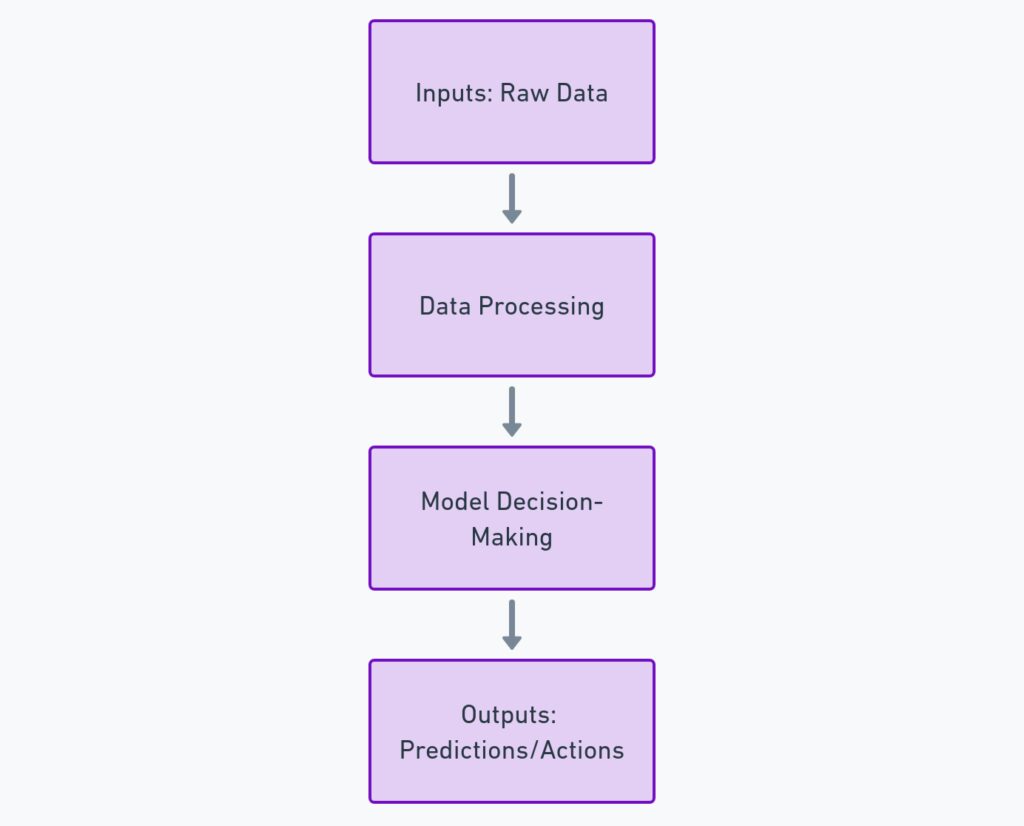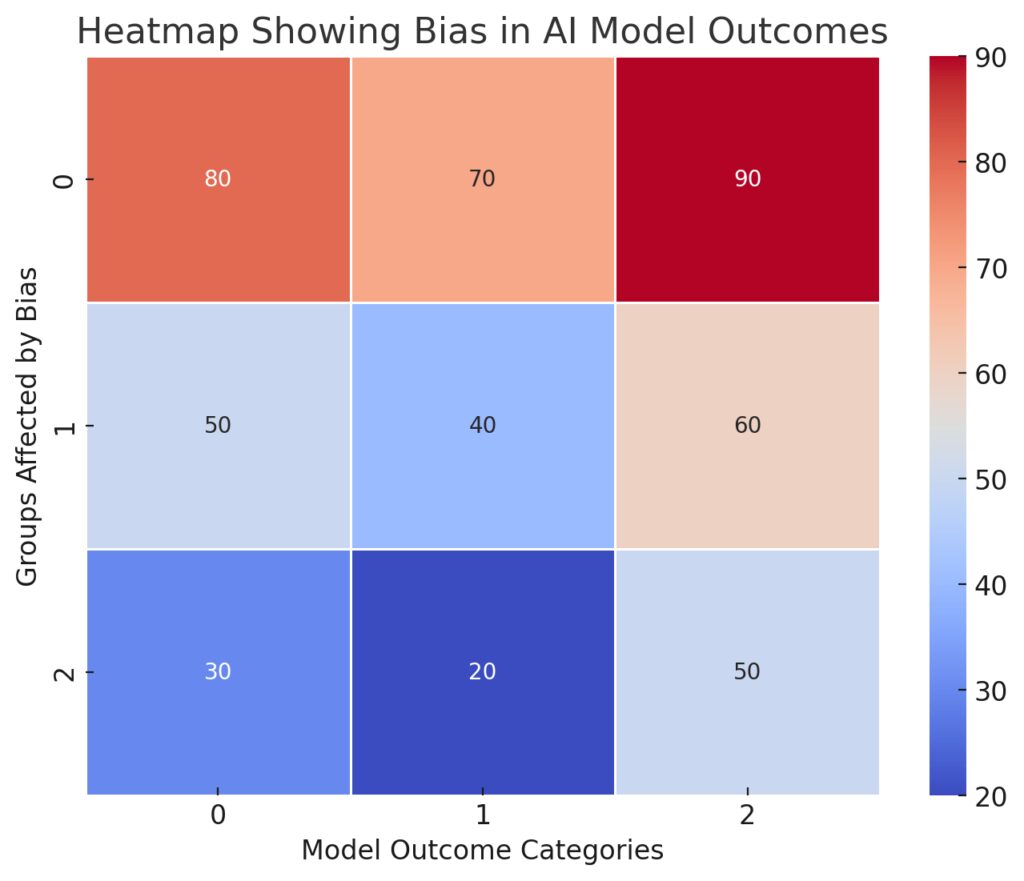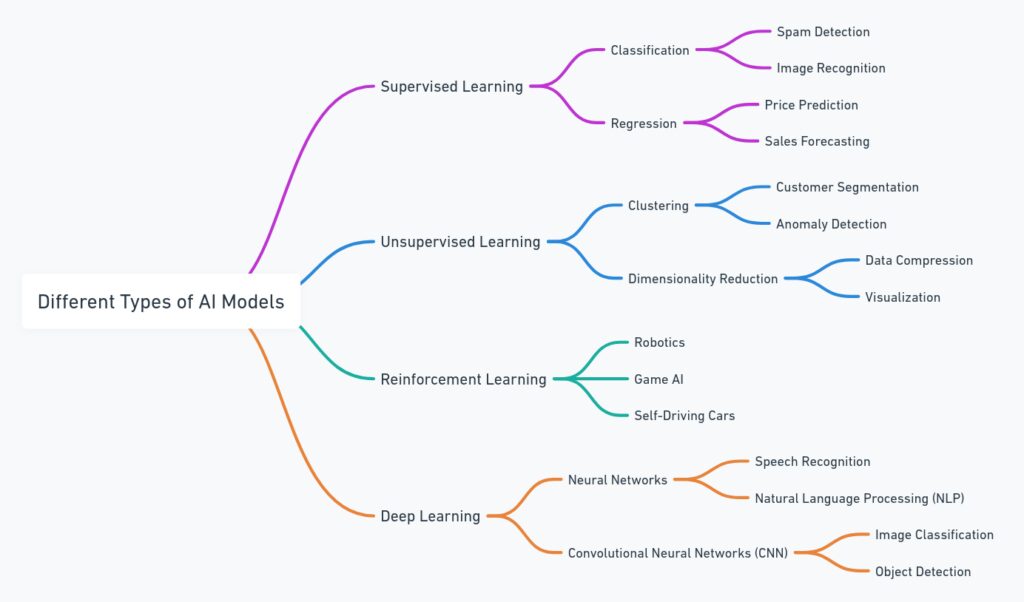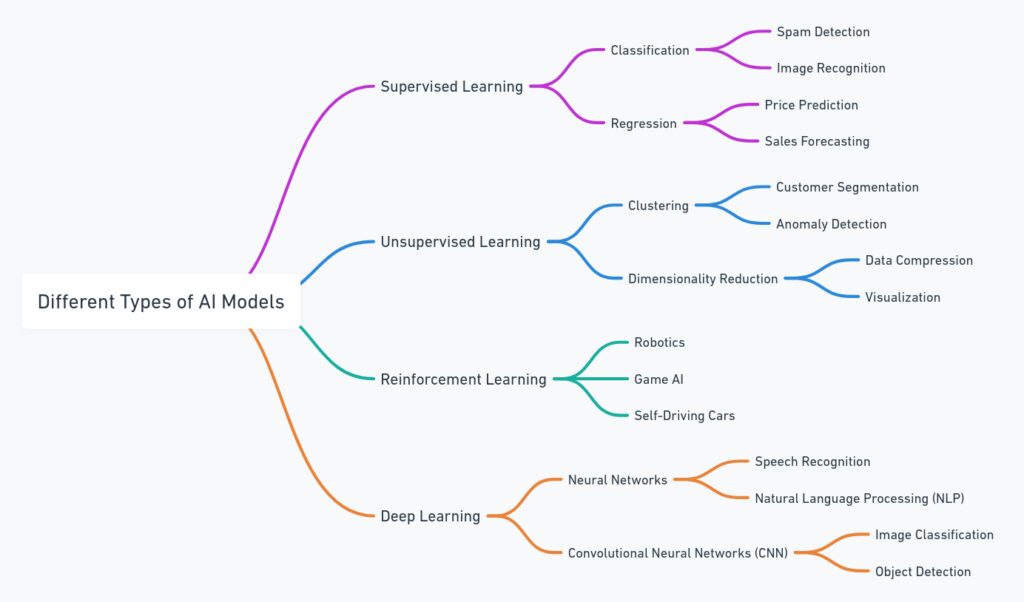
How Artificial Intelligence Models are Transforming Our World
AI is a transformative force shaping industries and lives. From chatbots answering our questions to algorithms that predict what we want to watch, AI is everywhere.
But, at the heart of this transformation are AI models, the powerful frameworks that drive the magic of machines “thinking” like humans.
AI models act as decision-makers, trained on data to perform specific tasks, whether that’s recognizing patterns, predicting trends, or generating new content. These models have enabled machines to go beyond just following instructions—they’re now capable of understanding, analyzing, and even creating. This is why AI models are seen as the future of innovation.
However, as AI integrates deeper into society, it’s worth understanding how these models work, and the challenges they present. Let’s dive into the fascinating world of AI models and explore how they’re reshaping the world we know.
The Basics of AI: What Exactly Are AI Models?
Before we get into the details, let’s break it down—what exactly are AI models? In simple terms, an AI model is a mathematical framework or system designed to make decisions based on data. The goal is to mimic human reasoning and problem-solving. Think of it as the brain of an AI system.

When we talk about AI models, we’re really talking about machines that have been trained to recognize patterns. These machines, once trained, can solve problems or perform tasks like language translation, medical diagnoses, or even creating art. The better the model, the smarter the machine appears to be.
There are different types of AI models, each with its own strengths. Some are better at recognizing images, while others excel at processing natural language. The key lies in the data—the more quality data the AI is exposed to, the better it can “learn” and perform its task.

Machine Learning: The Backbone of AI Models
Machine learning is like the driving engine behind AI models. Without it, we wouldn’t have the smart systems that we see today. This branch of AI focuses on training machines to learn from data without being explicitly programmed. The model makes predictions or decisions based on the patterns it finds in the data.
For example, consider how Spotify recommends songs to you. The AI looks at your past listening habits, compares them to millions of other users, and recommends songs you might like. This is all powered by machine learning models. The more data the system has, the more accurate the recommendations become.
Machine learning is also used in fields like finance, healthcare, and marketing. Its ability to predict trends, detect fraud, and provide personalized experiences is nothing short of revolutionary.

Deep Learning and Neural Networks: The Game Changer
If machine learning is the backbone of AI, deep learning is its high-powered muscle. Deep learning is a subset of machine learning that focuses on training multi-layered neural networks. These networks are designed to mimic how the human brain works—neurons, layers, and all.
This approach has led to breakthroughs in areas like speech recognition, image processing, and even gaming. Neural networks allow AI models to process complex data, such as recognizing a face in a crowded picture or understanding the nuances of human speech.
One of the reasons deep learning is so effective is because of its ability to analyze massive amounts of data quickly. For example, Google’s AI model was able to achieve superhuman performance in playing Go, an ancient board game, by processing millions of moves and strategies—something no human could ever achieve alone.
Natural Language Processing (NLP): Making Sense of Language
Another critical aspect of AI models is natural language processing (NLP). NLP focuses on teaching machines how to understand and interpret human language. Think about every time you ask Siri a question or type a query into Google—these systems use NLP to understand your intent and deliver results.
NLP models are trained to analyze text, determine context, and respond appropriately. This is why chatbots have become so effective in customer service. They can handle simple questions and tasks without human intervention.
However, NLP is still evolving. Teaching a machine to understand sarcasm, humor, or complex emotional expressions remains a challenge. Yet, with advancements in models like OpenAI’s GPT-4 and Google’s BERT, the gap between human and machine understanding continues to close.

Computer Vision: Teaching AI to See the World
One of the most exciting areas in AI is computer vision, which enables machines to interpret and understand visual data. Think of self-driving cars that recognize pedestrians or facial recognition systems unlocking your phone. These are all powered by advanced AI models designed to “see.”
Computer vision works by processing images or videos and analyzing the patterns in them. This requires an enormous amount of data because, unlike humans, machines don’t automatically know what a tree, face, or stop sign looks like. They have to be taught through thousands—sometimes millions—of labeled examples.
A growing application of this technology is in healthcare, where AI models can examine medical images to detect diseases like cancer with astonishing accuracy. By analyzing scans more quickly than a human, AI helps doctors catch issues earlier, leading to faster and more effective treatments.
Reinforcement Learning: How AI Learns from Mistakes
While traditional machine learning models rely on vast amounts of labeled data, reinforcement learning allows AI to learn through trial and error. This method mimics the way humans learn: by making decisions, receiving feedback, and adjusting future actions based on the outcome.
Take, for example, how AI systems have mastered video games. Instead of being told what’s right or wrong, the AI plays the game repeatedly, learning from its failures. Over time, it improves and can even develop strategies that surpass human capabilities.
Reinforcement learning isn’t just about games. It’s also applied in robotics, where machines learn how to perform physical tasks like walking or manipulating objects. This approach makes AI models far more flexible and adaptive, able to handle more complex, unpredictable environments.
Generative AI Models: Creating New Content, Not Just Replicating
Perhaps one of the most mind-blowing developments in AI is the rise of generative models. Unlike traditional models that focus on recognizing or predicting, these are designed to create entirely new content—whether it’s text, images, music, or even code.
A perfect example is OpenAI’s GPT models, which can generate human-like text on virtually any topic. You might have even encountered such models without realizing it—whether reading a computer-generated news article or interacting with a chatbot that felt eerily lifelike.
Generative AI is opening doors in the creative industry as well. AI can now generate artwork, design logos, and even write music. This doesn’t just speed up creative processes but also provides fresh perspectives that humans may not have considered.
How AI Models are Revolutionizing Healthcare
In the medical field, AI models are pushing boundaries. They’re assisting doctors in diagnosing diseases, suggesting treatments, and even predicting patient outcomes. By analyzing large datasets of medical records, AI can spot trends and make predictions faster than a human could.
Take cancer detection, for example. AI models can analyze mammograms and detect breast cancer with high precision, sometimes even surpassing human radiologists. These models sift through thousands of images to identify subtle patterns that would be easy to miss.
AI is also playing a significant role in personalized medicine. By analyzing a patient’s genetic makeup, lifestyle, and health history, AI can suggest highly tailored treatment plans. This leads to better outcomes and fewer side effects since treatments are designed specifically for that individual.
AI in Business: From Automation to Advanced Analytics
The use of AI models in business is growing rapidly, offering tools for everything from customer service automation to in-depth data analytics. Companies are using AI to improve efficiency, reduce costs, and deliver better customer experiences.
For instance, AI-driven chatbots handle routine customer inquiries, freeing up human agents to focus on more complex issues. Predictive analytics helps businesses make data-driven decisions, such as forecasting sales trends or identifying customer preferences.
In industries like retail, AI models are used to optimize supply chains, improve product recommendations, and even personalize marketing strategies.
Ethical Concerns Surrounding AI Models
As AI models continue to advance, ethical concerns become more pressing. One major issue is the potential for AI to replace human jobs. Automation, powered by AI, is already transforming industries like manufacturing and customer service. While it boosts efficiency, it also raises concerns about job displacement.
Another concern revolves around privacy. Many AI models require large amounts of personal data to function effectively, especially in fields like healthcare and finance. This creates potential risks around how data is collected, stored, and used. There’s a growing call for stricter regulations to protect individuals from data breaches and misuse.
Lastly, there’s the question of responsibility. If an AI system makes a decision—whether it’s a medical diagnosis or approving a loan—who is accountable if something goes wrong? As AI models gain more autonomy, ensuring proper oversight becomes crucial.
AI Bias: The Hidden Challenge in Data
AI models are only as good as the data they’re trained on, and that’s where bias creeps in. If the data fed into an AI system reflects existing biases in society, the model may replicate or even amplify those biases. This can have harmful effects, particularly in areas like hiring or law enforcement.
For example, AI used in hiring processes may unintentionally favor certain groups over others if trained on biased data. Similarly, predictive policing models, used to identify crime hotspots, have been criticized for disproportionately targeting minority communities based on historical crime data.

Solving the issue of bias in AI is no easy task. It requires careful selection of training data, continual monitoring, and collaboration between technologists, ethicists, and policymakers. The goal is to create AI models that are not only accurate but also fair and transparent.
The Role of AI in Autonomous Vehicles
Autonomous vehicles are one of the most high-profile applications of AI models. These cars rely on a combination of computer vision, sensor data, and machine learning to navigate roads safely without human intervention. While they promise to reduce accidents caused by human error, they also raise questions about safety and regulation.
Autonomous cars must be able to recognize pedestrians, traffic signals, and other vehicles, all while making split-second decisions. The AI models controlling these vehicles are constantly learning from data collected through test drives and simulations, improving their ability to handle complex driving environments.
However, the road to fully autonomous cars isn’t without bumps. High-profile accidents involving self-driving cars have sparked debate over the reliability of these AI models. Ensuring that autonomous systems are foolproof before they hit the mainstream remains a top priority for manufacturers and regulators.
Can AI Models Be Trusted? Understanding the Risks
Trusting AI models to make critical decisions—whether in healthcare, finance, or autonomous driving—can be challenging. While AI offers impressive accuracy and efficiency, it’s not immune to mistakes. Transparency in how AI models make decisions is crucial for building trust.
One issue is the “black box” nature of some AI systems, especially deep learning models. These systems can make incredibly accurate predictions, but the process behind those predictions is often opaque. This lack of explainability makes it difficult to understand how decisions are reached and whether they can be trusted.
Furthermore, AI systems can be vulnerable to adversarial attacks—where bad actors intentionally feed misleading data into the model, causing it to make incorrect decisions. These vulnerabilities highlight the need for robust security measures and constant monitoring to ensure AI models behave as expected.
The Future of AI Models: What’s Next?
The future of AI models is brimming with potential. We’re only scratching the surface of what AI can do, and the advancements we see today are paving the way for even more revolutionary changes. Researchers are working on creating more generalized AI models, which can adapt to a wider variety of tasks, moving beyond specialized models that only excel in one area.
One of the most anticipated advancements is AI-human collaboration. Instead of replacing humans, AI will work alongside them, augmenting our abilities and taking over repetitive or dangerous tasks. We’re also seeing the rise of ethical AI development, focusing on creating models that prioritize fairness, transparency, and privacy.
In the coming years, AI could reshape industries that haven’t even been touched by it yet. From space exploration to tackling climate change, AI models will play a crucial role in solving some of humanity’s biggest challenges. The question isn’t whether AI will shape the future—but how, and in what direction.
FAQs
What is an AI model?
An AI model is a mathematical system or framework designed to make decisions or predictions based on data. These models are trained to recognize patterns and solve specific problems, such as recognizing images, predicting outcomes, or understanding language.
How do AI models learn?
AI models, especially those using machine learning, learn by being exposed to large amounts of data. They identify patterns in this data, allowing them to improve over time. The more data they process, the better they get at making accurate predictions or performing tasks.
What are the different types of AI models?

f AI models?
There are several types of AI models, including:
- Supervised learning models (trained with labeled data)
- Unsupervised learning models (find patterns without labels)
- Deep learning models (use neural networks to mimic the brain)
- Reinforcement learning models (learn through trial and error)
What is deep learning?

Deep learning is a subset of machine learning that uses multi-layered neural networks. These networks enable AI to process large amounts of complex data, such as images, videos, or sound. Deep learning powers advanced applications like voice recognition and self-driving cars.
How does AI understand language?
Through Natural Language Processing (NLP). NLP models teach machines to interpret, understand, and respond to human language. This allows AI to handle tasks like language translation, answering questions, or even engaging in conversation, as seen in virtual assistants like Siri or Alexa.
Can AI models create original content?
Yes, with generative AI models. These models are trained to create new content, whether it’s text, music, images, or even video. Tools like OpenAI’s GPT-4 can write stories, generate code, or answer complex questions by creating original content based on the data they’ve learned from.
What is the role of AI in healthcare?
AI models in healthcare are transforming the industry by improving diagnostics, personalizing treatment plans, and predicting patient outcomes. AI can analyze medical images faster and often more accurately than humans, helping detect diseases like cancer at earlier stages.
What is reinforcement learning?
Reinforcement learning is a type of AI learning where models learn from their mistakes. The AI takes actions, receives feedback (positive or negative), and adjusts its future actions based on that feedback. It’s used in areas like robotics, gaming, and autonomous systems.
| Learning Method | Pros | Cons | Best Use Case |
|---|
| Reinforcement Learning | – Learns through trial and error. – Great for dynamic and unpredictable environments. – Can develop complex strategies over time. | – Requires large amounts of data and computational resources. – Learning can be slow. – Hard to apply to simple tasks. | – Robotics – Game AI (e.g., AlphaGo) – Autonomous systems |
| Supervised Learning | – Fast learning from labeled data. – High accuracy in tasks like classification and prediction. – Easier to implement for common problems. | – Requires vast amounts of labeled data. – Struggles with complex environments or incomplete data. | – Image and speech recognition. – Spam filtering. – Medical diagnoses. |
| Unsupervised Learning | – Finds hidden patterns in data. – No need for labeled data. – Good for exploratory analysis. | – Harder to evaluate accuracy. – Can produce less predictable or interpretable results. – Needs large datasets. | – Customer segmentation. – Anomaly detection. – Market basket analysis. |
Is AI biased?
Yes, AI models can exhibit bias if they are trained on biased data. If the data used to train an AI system reflects existing inequalities or stereotypes, the model may perpetuate or even amplify those biases in its decisions. This is a major ethical challenge in AI development.
Can AI replace human jobs?
AI is automating many tasks, especially repetitive or manual jobs, leading to concerns about job displacement. However, AI is also creating new opportunities by enhancing human capabilities, allowing workers to focus on more complex, creative, and value-added tasks.
What are the ethical concerns surrounding AI?
Ethical concerns include:
- Data privacy (AI requires large amounts of data, raising privacy risks)
- Job displacement (automation potentially replacing human jobs)
- Bias (models may replicate societal biases)
- Accountability (if AI makes a mistake, who is responsible?)
What is the future of AI models?
The future of AI models lies in creating more generalized AI systems that can handle multiple tasks, greater collaboration between humans and AI, and developing models that prioritize ethics, fairness, and transparency. AI will likely continue to shape industries from healthcare to transportation, opening up new possibilities.
Resources
- Machine Learning Basics
If you’re new to AI and want a deeper understanding of machine learning, check out this introductory guide by Google:
Google AI: Machine Learning Crash Course - Deep Learning and Neural Networks
Learn more about deep learning and how neural networks power today’s most advanced AI models with this excellent resource from MIT:
MIT Deep Learning for Self-Driving Cars - Understanding AI Ethics and Bias
To explore the ethical challenges of AI and how bias in AI models can affect outcomes, the AI Ethics Guidelines by the European Commission are a great starting point:
European Commission: Ethics Guidelines for Trustworthy AI - NLP and Language Models
Dive deeper into natural language processing (NLP) with this easy-to-understand guide from Stanford:
Stanford NLP Group - Healthcare AI Applications
For a more focused look at how AI is impacting healthcare, read this detailed report by the World Health Organization:
WHO: Ethics and Governance of Artificial Intelligence for Health